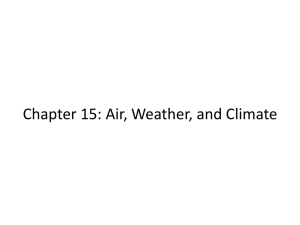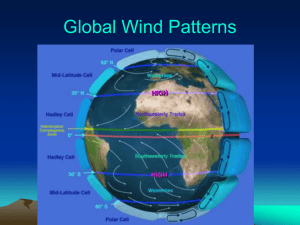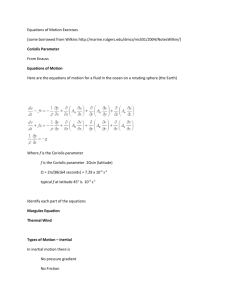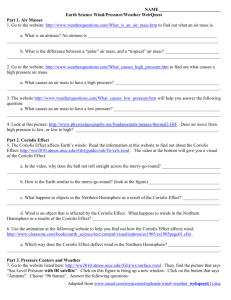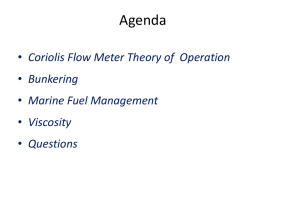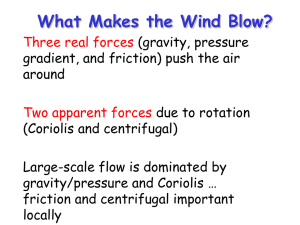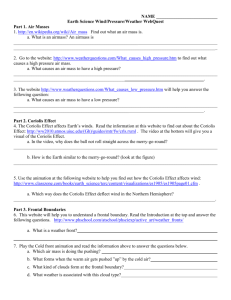Coriolis Effect Article
advertisement
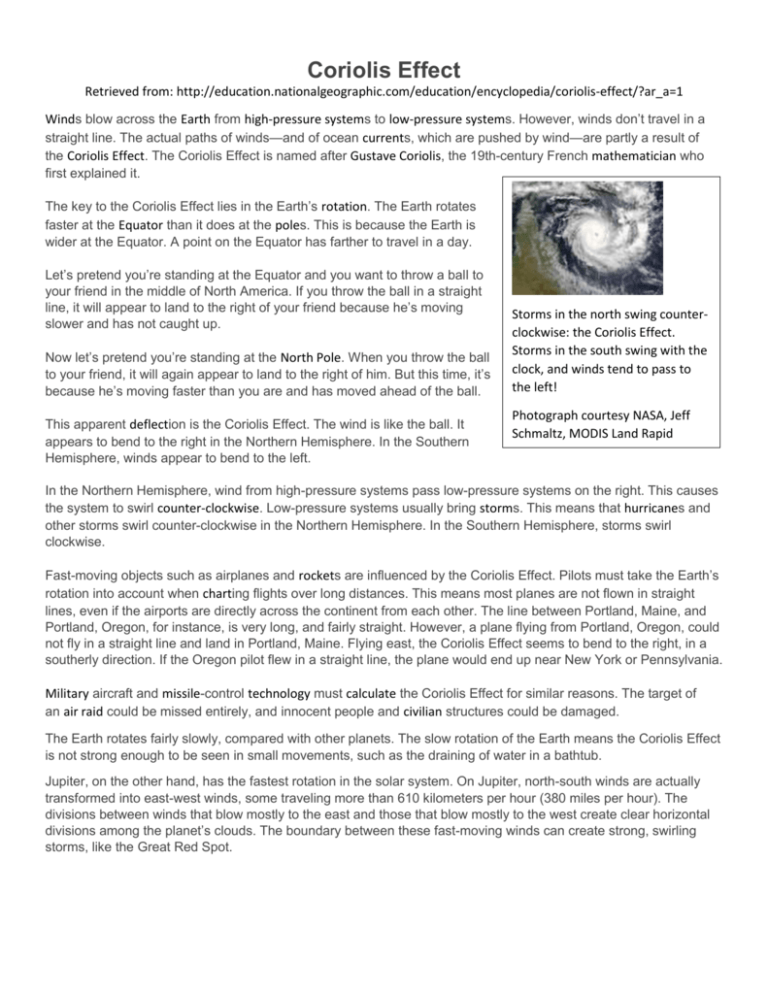
Coriolis Effect Retrieved from: http://education.nationalgeographic.com/education/encyclopedia/coriolis-effect/?ar_a=1 Winds blow across the Earth from high-pressure systems to low-pressure systems. However, winds don’t travel in a straight line. The actual paths of winds—and of ocean currents, which are pushed by wind—are partly a result of the Coriolis Effect. The Coriolis Effect is named after Gustave Coriolis, the 19th-century French mathematician who first explained it. The key to the Coriolis Effect lies in the Earth’s rotation. The Earth rotates faster at the Equator than it does at the poles. This is because the Earth is wider at the Equator. A point on the Equator has farther to travel in a day. Let’s pretend you’re standing at the Equator and you want to throw a ball to your friend in the middle of North America. If you throw the ball in a straight line, it will appear to land to the right of your friend because he’s moving slower and has not caught up. Now let’s pretend you’re standing at the North Pole. When you throw the ball to your friend, it will again appear to land to the right of him. But this time, it’s because he’s moving faster than you are and has moved ahead of the ball. Storms in the north swing counterclockwise: the Coriolis Effect. Storms in the south swing with the clock, and winds tend to pass to the left! This apparent deflection is the Coriolis Effect. The wind is like the ball. It appears to bend to the right in the Northern Hemisphere. In the Southern Hemisphere, winds appear to bend to the left. Photograph courtesy NASA, Jeff Schmaltz, MODIS Land Rapid Response Team at NASA GSFC In the Northern Hemisphere, wind from high-pressure systems pass low-pressure systems on the right. This causes the system to swirl counter-clockwise. Low-pressure systems usually bring storms. This means that hurricanes and other storms swirl counter-clockwise in the Northern Hemisphere. In the Southern Hemisphere, storms swirl clockwise. Fast-moving objects such as airplanes and rockets are influenced by the Coriolis Effect. Pilots must take the Earth’s rotation into account when charting flights over long distances. This means most planes are not flown in straight lines, even if the airports are directly across the continent from each other. The line between Portland, Maine, and Portland, Oregon, for instance, is very long, and fairly straight. However, a plane flying from Portland, Oregon, could not fly in a straight line and land in Portland, Maine. Flying east, the Coriolis Effect seems to bend to the right, in a southerly direction. If the Oregon pilot flew in a straight line, the plane would end up near New York or Pennsylvania. Military aircraft and missile-control technology must calculate the Coriolis Effect for similar reasons. The target of an air raid could be missed entirely, and innocent people and civilian structures could be damaged. The Earth rotates fairly slowly, compared with other planets. The slow rotation of the Earth means the Coriolis Effect is not strong enough to be seen in small movements, such as the draining of water in a bathtub. Jupiter, on the other hand, has the fastest rotation in the solar system. On Jupiter, north-south winds are actually transformed into east-west winds, some traveling more than 610 kilometers per hour (380 miles per hour). The divisions between winds that blow mostly to the east and those that blow mostly to the west create clear horizontal divisions among the planet’s clouds. The boundary between these fast-moving winds can create strong, swirling storms, like the Great Red Spot. Closer to home, you could observe the Coriolis Effect if you and a friend stood on a rotating merry-go-round and threw a ball back and forth. To you and your friend, the ball’s path would appear to curve. Actually, the ball would be traveling in a straight line. You and your friend would be moving out of its path while it is in the air. A third person, standing on the ground near the merry-go-round, would be able to confirm that the ball travels in a straight line. Coriolis Force/Effect The invisible force that appears to deflect the wind is the Coriolis force. The Coriolis force applies to movement on rotating objects. It is determined by the mass of the object and the object's rate of rotation. The Coriolis force is perpendicular to the object's axis. The Earth spins on its axis from west to east. The Coriolis force, therefore, acts in a north-south direction. The Coriolis force is zero at the Equator. Though the Coriolis force is useful in mathematical equations, there is actually no physical force involved. Instead, it is just the ground moving at a different speed than an object in the air. 3 VISUALIZATIONS 1. 2. 3. 3 MAIN IDEAS WITH SUPPORTING EVIDENCE 1. 2. 3.


